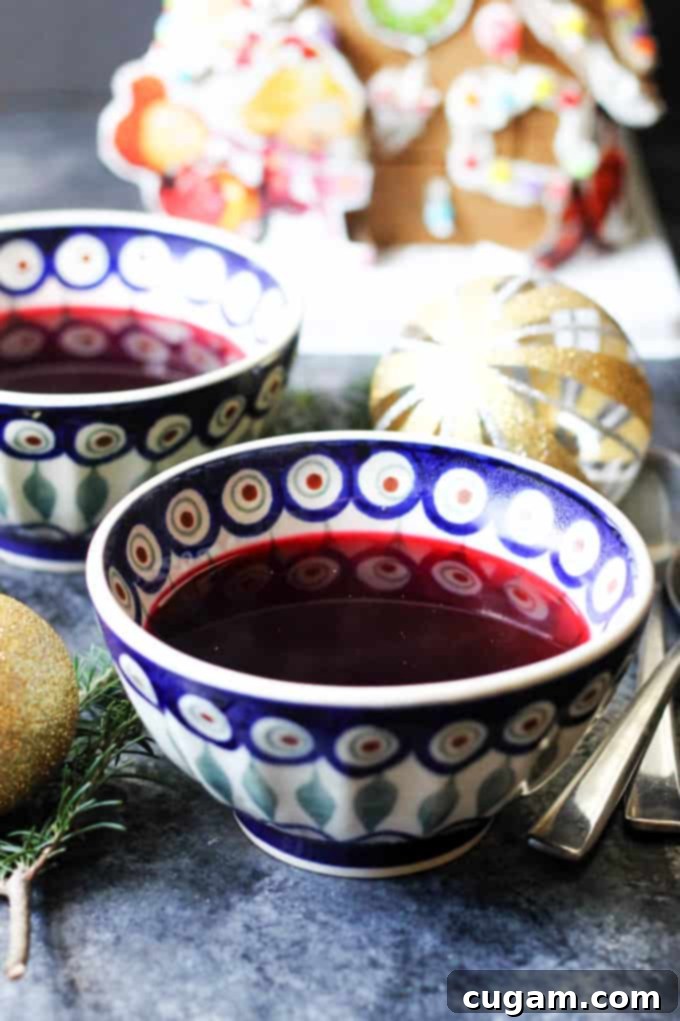Authentic Polish Borscht (Barszcz Czerwony): Your Essential Christmas Eve Soup Guide
Borscht, known in Poland as Barszcz Czerwony, is more than just a soup; it’s a culinary cornerstone of Polish Christmas Eve (Wigilia) celebrations. This traditional beet-based broth, characterized by its vibrant red hue and clean, almost transparent consistency, holds a special place in the hearts and homes of Poles worldwide. While often served simply in mugs as a warming drink, it truly shines when presented in bowls, accompanied by delicate Polish mushroom “uszka” pierogi or hearty Sauerkraut and Mushroom Pierogi.
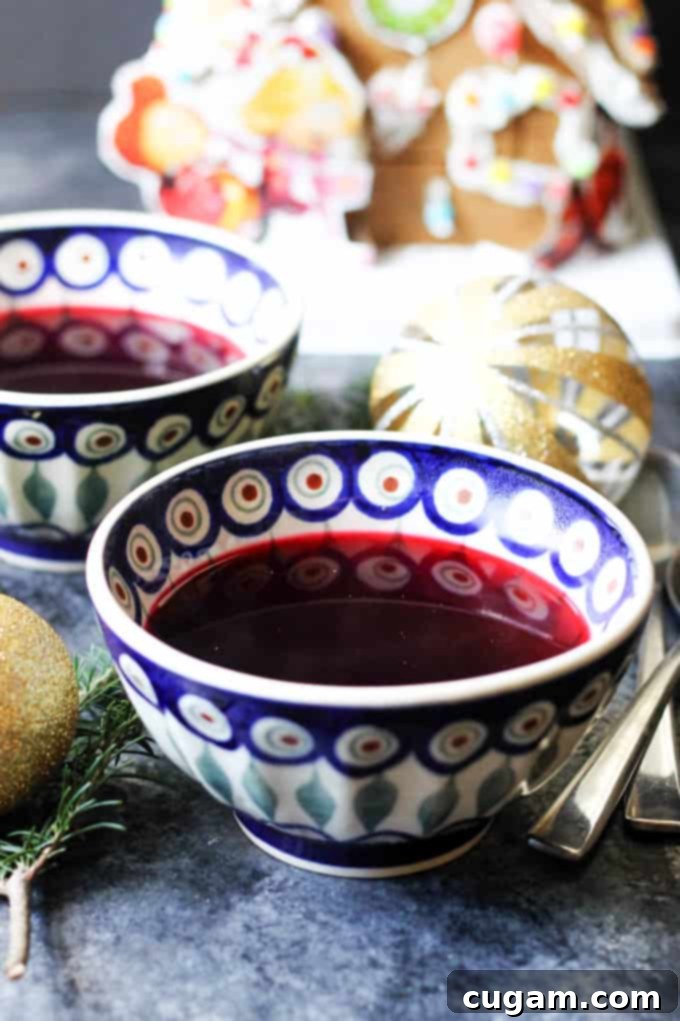 Borscht – Traditional Polish Soup Served on Christmas Eve
Borscht – Traditional Polish Soup Served on Christmas Eve
The Heart of a Polish Christmas Eve: Clean Red Borscht
Clean red borscht (Barszcz Czysty Czerwony) is an indispensable dish gracing the tables of most Polish families during Christmas Eve supper, known as Wigilia. While some households might opt for mushroom soup, in my family, this traditional Polish borscht has always been the star of our Wigilia feast. It’s a cherished tradition I proudly carried with me when I moved to America. Making it once a year for Christmas Eve has become a heartwarming ritual, a taste of home that my family and I eagerly anticipate during the festive season. The aroma of simmering beets and earthy mushrooms instantly transports us back to the warmth of Polish holiday traditions.
If you’re curious to explore more about the rich and diverse Polish Christmas Eve culinary traditions, I’ve shared more insights in my post for Authentic Polish Pierogi with Potato and Cheese. There, I recount how much my American relatives have come to adore these traditional dishes, proving that good food truly transcends cultural boundaries and brings families closer.
I frequently receive requests from my wonderful readers for more authentic Polish recipes, often seeking those beloved dishes their grandmas used to prepare. It’s a testament to the enduring appeal of homemade, traditional comfort food. So, I’m thrilled to share this classic Polish borscht recipe, crafted with simple, readily available ingredients that you can find in any American grocery store. As always, I’ll also present a few alternative methods and tips to help you achieve the perfect bowl of barszcz, tailored to your preferences and resources.
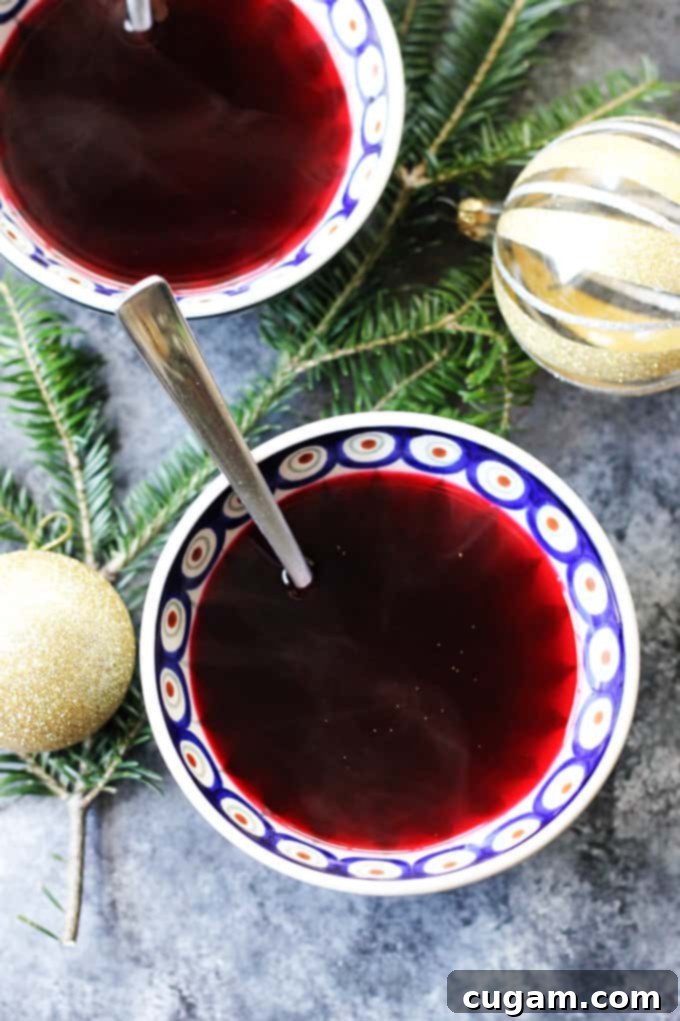
Essential Ingredients for Authentic Polish Red Borscht
Crafting a truly authentic Polish borscht starts with a selection of fresh, simple, yet incredibly flavorful ingredients. What’s wonderful about this recipe is that all the core components are easily accessible and can be found in almost any well-stocked grocery store. This makes recreating this beloved Polish classic a breeze, no matter where you are. Here’s your comprehensive shopping list:
- **Beets:** The star of the show, providing the iconic color and earthy sweetness. Choose firm, fresh beets for the best flavor.
- **Apple:** Adds a subtle sweetness and crucial acidity, balancing the earthy beet flavor and contributing to the soup’s complexity.
- **Carrots:** Lends a foundational sweetness and depth to the vegetable broth.
- **Celery Root (Celeriac):** Offers a distinct, slightly nutty, and earthy flavor that is essential for a traditional Polish broth. Don’t skip this!
- **Parsnip:** Contributes a delicate sweetness and peppery undertone, enriching the overall flavor profile.
- **Leeks:** Provides an onion-like sweetness and mild pungency, enhancing the aromatic base.
- **Dry Porcini Mushrooms:** These are key for an intensely umami, earthy flavor that defines a true Polish borscht, especially for Wigilia.
- **Garlic:** Aromatic and pungent, garlic is essential for depth and warmth.
- **Parsley:** Fresh parsley adds a hint of freshness and herbaceous notes to the broth.

The Secret to Flavor: Spices and Seasonings for Polish Borscht
While the fresh vegetables lay the groundwork, it’s the carefully selected spices and pantry staples that truly elevate Polish borscht to its iconic status. These ingredients are **critical for developing a super flavorful and delicious soup** that is both aromatic and perfectly balanced. Here’s what you’ll need to infuse your borscht with traditional Polish taste:
- **Bay Leaves:** Provide a subtle, herbal aroma that is a classic base for many European soups and stews.
- **Whole Allspice:** Delivers a warm, complex flavor reminiscent of cloves, nutmeg, and cinnamon, without overpowering the beets.
- **Dry Marjoram:** This herb is indispensable in Polish cuisine, especially for borscht. It offers a slightly floral, earthy, and peppery note that is characteristic of the dish. Be sure to use dried marjoram leaves, not powdered, for the best aroma and flavor release.
- **Salt:** Essential for seasoning and bringing out the natural flavors of all ingredients.
- **Pepper:** Freshly ground black pepper adds a hint of spice and warmth.
- **Sugar:** A touch of sugar helps to balance the acidity and enhance the natural sweetness of the beets and other root vegetables.
- **Lemon Juice:** Crucial for brightening the flavors and, importantly, helping to preserve the beets’ vibrant red color during cooking.
- **White Vinegar:** Like lemon juice, vinegar adds a necessary tartness and plays a key role in setting and intensifying the beautiful crimson hue of the borscht.
Crafting Authentic Beetroot Borscht: A Step-by-Step Guide
The process of making **authentic Polish borscht** is a delightful journey of flavor extraction and careful seasoning. It’s a two-stage process: first, creating a rich vegetable and mushroom broth, and then infusing it with the vibrant beet flavor. Patience and attention to detail will result in a truly remarkable soup. Here’s how you’ll do it:
Step 1: Rehydrate the Dried Mushrooms. Begin by placing your dry porcini mushrooms in a heatproof bowl. Cover them generously with hot boiling water. Allow them to soak for at least 5 minutes. This softens them and releases their deep umami flavor. *Keep the soaking liquid, but be mindful of any sand that may settle at the bottom.*
Step 2: Prepare the Broth Vegetables. While the mushrooms soak, peel, wash, and cut your root vegetables and aromatics into large chunks. This includes carrots, parsnip, celery root, leeks, and parsley. Large pieces are ideal for a clear broth as they are easier to strain later.
Step 3: Simmer the Broth. Transfer your prepared vegetables and the soaked mushrooms to a large pot. Carefully pour in some of the mushroom soaking water, straining it through a fine-mesh sieve or cheesecloth to catch any potential sand at the bottom. Add enough fresh water to cover all the ingredients (approximately 10 cups for 8 servings). Season with a tablespoon of salt, bay leaves, and allspice. Bring to a boil, then reduce the heat and simmer, uncovered, for about 30 minutes. Simmering uncovered allows the flavors to concentrate and prevents the broth from becoming cloudy.
Step 4: Prepare the Beets, Garlic, and Apple. While the broth simmers, prepare the remaining ingredients. Peel the beets and slice them into approximately 1/2-inch thick pieces. Peel your garlic cloves, and slice the apple (leaving the skin on for extra flavor and nutrients).
Step 5: Infuse with Beets and Final Spices. Add the sliced beets, garlic, and apple to your simmering vegetable broth. This is also the time to add your initial seasonings: salt, sugar, and the crucial dried marjoram. To preserve the beets’ beautiful, intense red color, immediately add one tablespoon of white vinegar and one tablespoon of fresh lemon juice. Continue to cook, uncovered, for another half hour. Overcooking beets can dull their color, so this timing is important.
Step 6: Adjust Seasoning. After 30 minutes, taste your borscht. Add the remaining vinegar, and then adjust the seasoning as needed with additional vinegar, sugar, salt, and freshly ground pepper. The goal is a perfect balance of sweet, sour, and savory. Don’t be shy about tasting and tweaking until it’s just right.
Step 7: Strain and Serve. Carefully discard all the cooked vegetables and mushrooms from the pot. Using a fine-mesh strainer or cheesecloth-lined colander, pour your clean, vibrant borscht into mugs for drinking or into bowls to be served alongside traditional mushroom pierogi or other Christmas Eve accompaniments. The clear consistency is a hallmark of authentic Barszcz Czysty Czerwony.
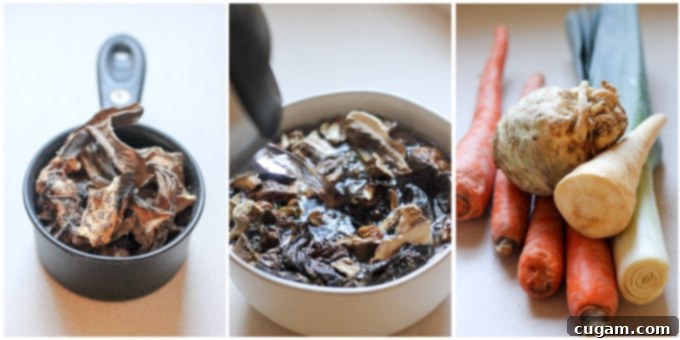
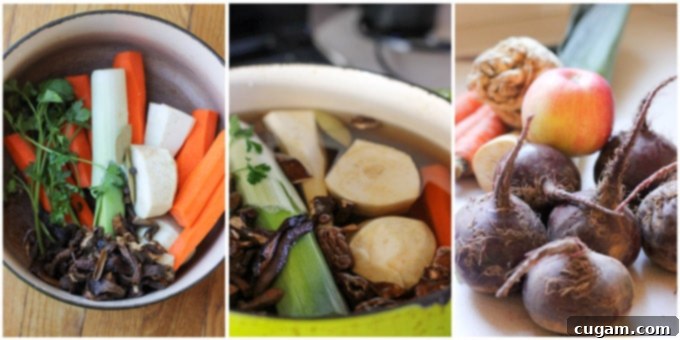
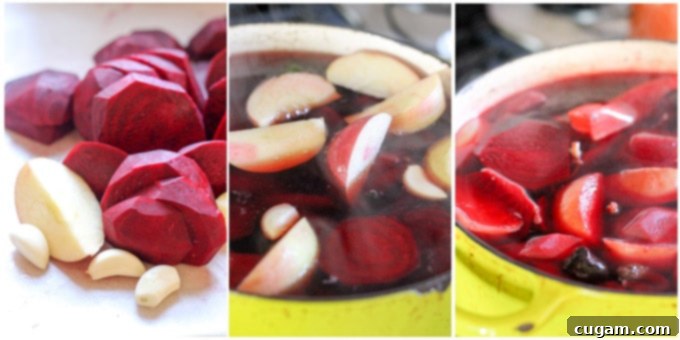
Beyond the Basic: Other Methods to Prepare Polish Red Borscht
While the method described above uses ingredients easily found in any grocery store, there are alternative approaches to making Polish red borscht, especially if you have access to specialty Polish products or prefer a more traditional fermentation method. These options offer different flavor profiles and levels of convenience.
Borscht with Beet Concentrate for Added Convenience
If you’re fortunate enough to live near a Polish specialty grocery store, you might encounter a product called **Beet Concentrate**. This is essentially a highly concentrated form of borscht, packed with intense beet flavor. I often incorporate it into my borscht for an extra layer of richness and a deeper red color. However, using concentrate requires a slight adjustment to your cooking method.
When preparing your initial vegetable broth, use very little salt, as the beet concentrate itself is quite salty. It’s much easier to adjust the seasoning at the end to avoid an overly salty soup. Once your vegetable broth is cooked and strained, add your sliced beets, garlic, and apple. Then, add about half a bottle of the beet concentrate. At this stage, **do not add sugar, vinegar, lemon juice, salt, or other spices**, as these flavors are already present and concentrated in the product. Let the mixture cook for approximately half an hour, then taste.
At this point, you can gradually add more concentrate, a little at a time, until you achieve your desired balance of acidity, sweetness, and depth of flavor. Only then, if necessary, adjust with additional salt and pepper. This method is excellent for boosting flavor and achieving a consistent color, especially when time is a factor.
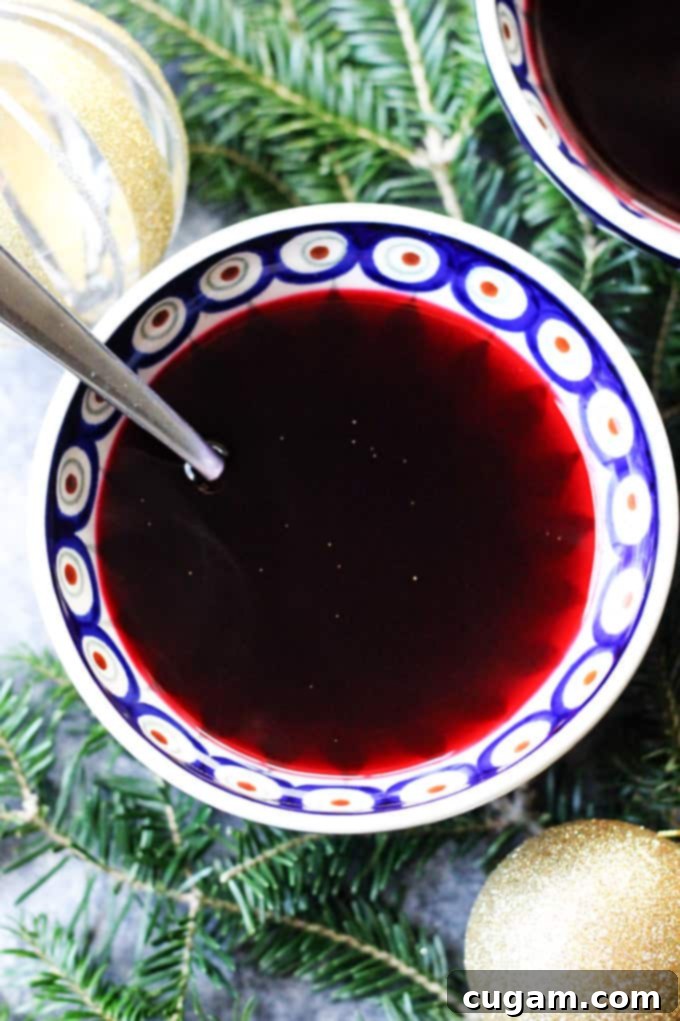
Borscht Using Homemade Beet Kvass: A Traditional Approach
A truly traditional and ancient method found in many Polish homes involves using **beet kvass** instead of commercial vinegar or beet concentrate. Beet kvass is a fermented beet drink, rich in probiotics and with a distinct tangy, earthy flavor. I personally adore beet kvass and we drink it regularly in our home for its health benefits.
If you choose this method, you’ll need to prepare your beet kvass approximately 5 days before you plan to make your borscht. You can find my detailed recipe for homemade beet kvass here. The kvass will replace the vinegar and lemon juice in the recipe. Also, be aware that beet kvass naturally contains salt from the fermentation process, so be very sparing with any added salt until the very end of your borscht preparation.
To make borscht using beet kvass, you will start by preparing the vegetable and mushroom broth in the same initial manner. Once you add the beets, apples, and garlic to the broth, you would then incorporate approximately 1 cup of your homemade beet kvass. Allow the soup to cook for another half hour. After this simmering time, taste and adjust with more kvass and seasonings (salt, pepper, sugar) as needed, until you reach your desired flavor profile.
Here’s my personal reasoning for not typically using beet kvass in my cooked borscht. While beet kvass is a fantastic source of beneficial bacteria and nutrients, the cooking process involved in making borscht will unfortunately kill these valuable probiotics. In my opinion, it’s more effective to use standard vinegar and lemon juice for the borscht’s acidity and continue to enjoy beet kvass separately as a healthful drink. However, this is purely a personal preference, and many traditional cooks swear by kvass for its unique flavor contribution. Ultimately, you have excellent options here, so choose the method that best suits your taste and culinary philosophy!
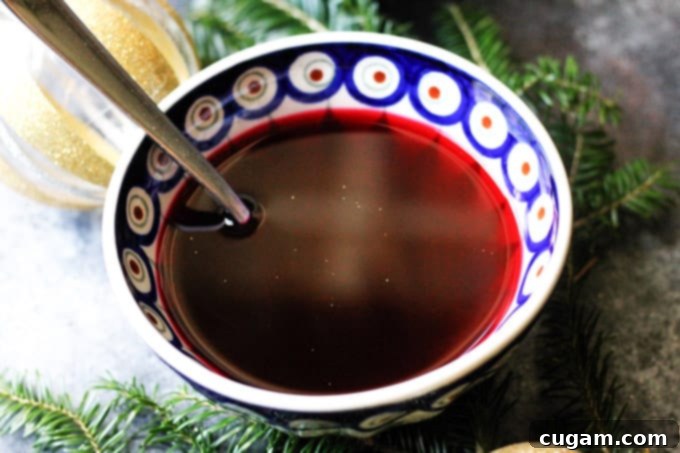
Serving Suggestions for Polish Borscht
While the text mentions serving borscht with “uszka” pierogi or Sauerkraut and Mushroom Pierogi, there are many other delightful ways to enjoy this classic Polish soup. For Wigilia, its clear broth is often served as the very first course, sometimes even simply in a mug to be sipped and savored. However, when serving it in a bowl, here are some traditional and modern accompaniments:
- **Mushroom “Uszka” Pierogi:** These small, ear-shaped dumplings filled with wild mushrooms are the quintessential pairing for Christmas Eve borscht.
- **Sauerkraut and Mushroom Pierogi:** Another popular pierogi choice, offering a tangy and savory counterpoint to the sweet earthiness of the borscht.
- **Krokiety (Croquettes):** Crispy, pan-fried crepes filled with mushrooms and sauerkraut, perfect for dipping into the warm soup.
- **Paszteciki (Savory Pastries):** Small, flaky pastries often filled with meat or mushrooms, serving as a delightful side.
- **Boiled Potatoes:** Simple, comforting, and a great way to make the soup more substantial.
- **Fresh, Crusty Bread:** To soak up every last drop of the flavorful broth.
- **Sour Cream or Fresh Dill:** While not traditionally added to “clean” borscht, some prefer a dollop of sour cream or a sprinkle of fresh dill for added richness and aroma, especially if serving a heartier, non-Wigilia version.
No matter how you choose to serve it, this homemade Polish borscht is guaranteed to bring warmth, tradition, and incredible flavor to your table.
Other Traditional Polish Recipes Often Served on Christmas Eve
The Wigilia supper is a meatless feast, rich with symbolic dishes. Beyond borscht, here are some other beloved Polish recipes that frequently appear on the Christmas Eve table:
- Sauerkraut and Mushroom Pierogi
- Pierogi with Potato and Cheese
- Bigos – Polish Hunter’s Stew (often a version without meat for Wigilia, or the meat version served on Christmas Day)
- Kapusta – Sauerkraut and Mushrooms
- Russian Salad (Olivier Salad or Salatka Jarzynowa)
And Here are Amazing Christmas Cookies to Complete Your Holiday Spread
- Linzer Cookies (Traditional Czech Recipe)
- 5 Ingredients Butter Vanilla Cookies
- 20 European Christmas Cookies Recipes
What is your own traditional recipe that is served on Christmas Eve? I’d love to hear about it – let me know in the comments below, I’m always curious about culinary traditions from around the world!
Here’s Your Printable Recipe for Borscht
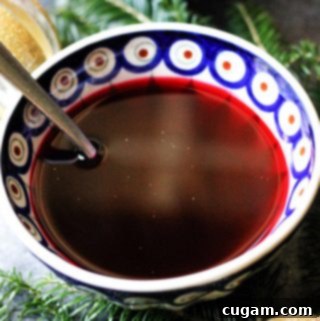
Borscht (Authentic Polish Recipe)
Print
Pin
Rate
Ingredients
- 4 Carrots medium size
- 1 Parsnip medium size
- 1/2 Celery root If it’s big then 1/4 will be enough
- 1 Leek
- 4 sprig Parsley
- 1 cup Dried Porcini Mushrooms
- 2 Bay leaves
- 4 whole Allspice
- 6 Beets medium size
- 1 Apple any kind, sliced with the skin
- 3 cloves Garlic peeled
- 2 tbsp White Vinegar + more if needed
- 1 tbsp Lemon Juice freshly squeezed
- 2 teaspoon Sugar + more if needed
- 2 tbsp Salt + more if needed
- 1/4 teaspoon Marjoram dry
- Freshly ground pepper to taste
Instructions
-
Place dry mushrooms in a bowl and cover them with hot boiling water. Let them soak for 5 minutes.
-
Peel, wash, and cut into chunks your vegetables (carrots, parsnip, celery root, leeks, and parsley);
-
Place your vegetables and soaked mushrooms* (see notes below) in the large pot, cover with 10 cups of water, add a tablespoon of salt, bay leaves, and allspice, and boil for about 30 minutes, uncovered;
-
Prepare beets – peel them and slice in 1/2 inch slices; peel your garlic and slice the apple;
-
Add beets, garlic, apple, and spices (salt, sugar, and marjoram) to the vegetable broth. At this time, add 1 tablespoon of vinegar and one tablespoon of lemon to preserve the beautiful color of the beets. Cook it for another half hour, uncovered;
-
Add the remaining vinegar, and adjust the seasoning with vinegar, sugar, salt & pepper, as needed.
-
Discard all the vegetables and use a strainer to pour your borscht either into mugs to drink or to bowls to be served with mushroom pierogi.
Notes
Nutrition
Read more about the author Edyta here and connect with Eating European on social media for more delicious recipes and culinary inspiration: Facebook, Instagram, Pinterest, and Twitter.
